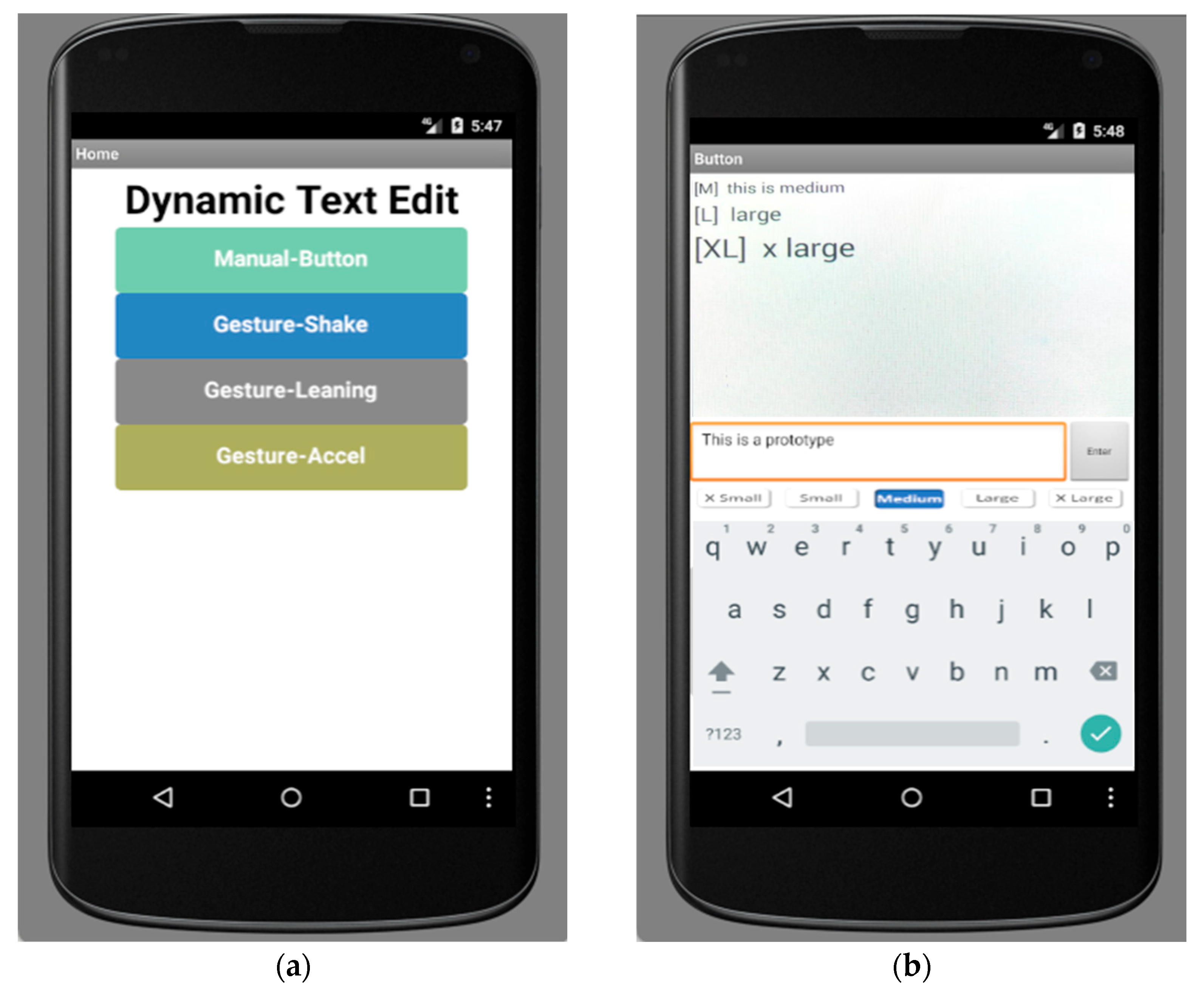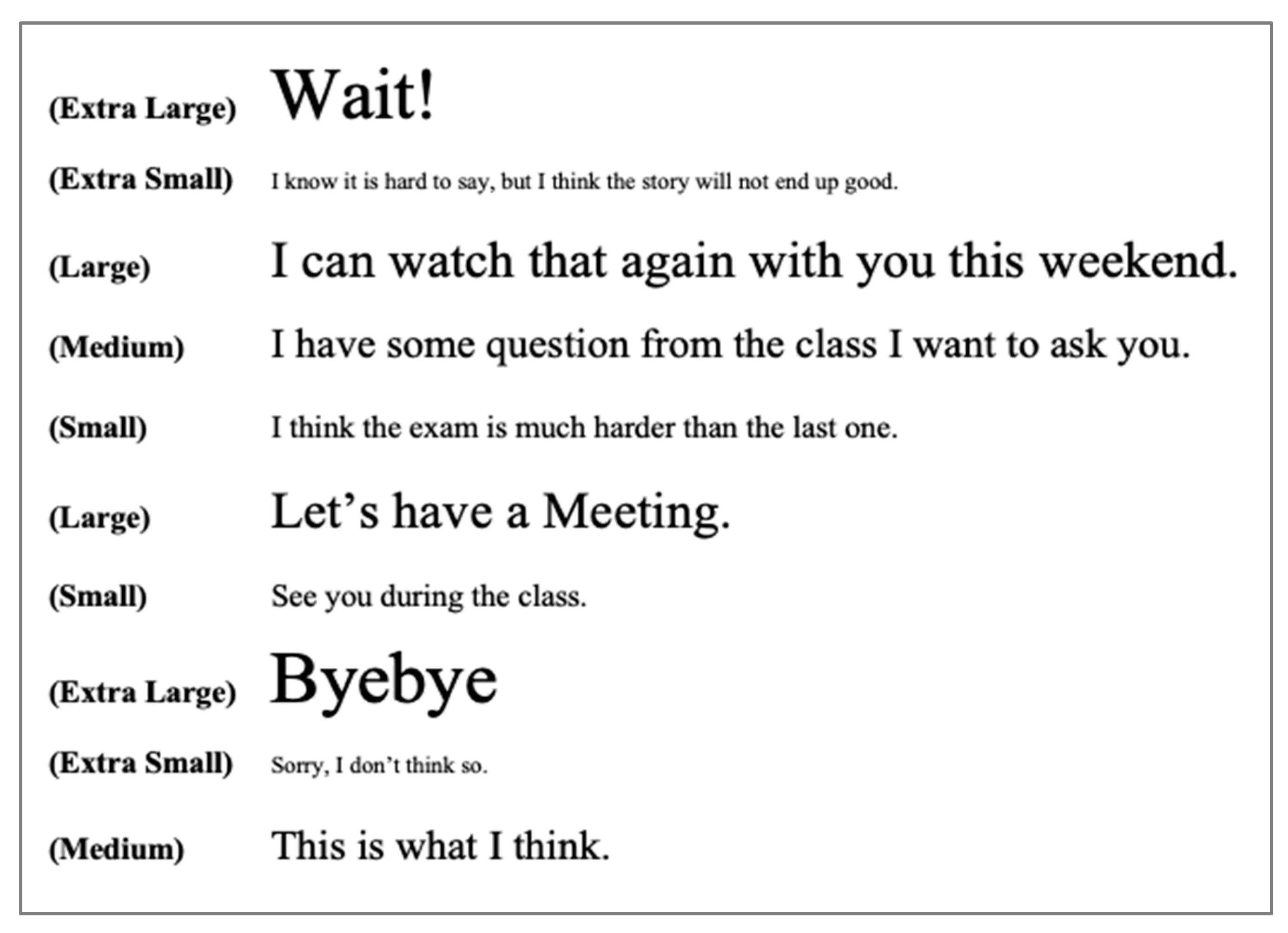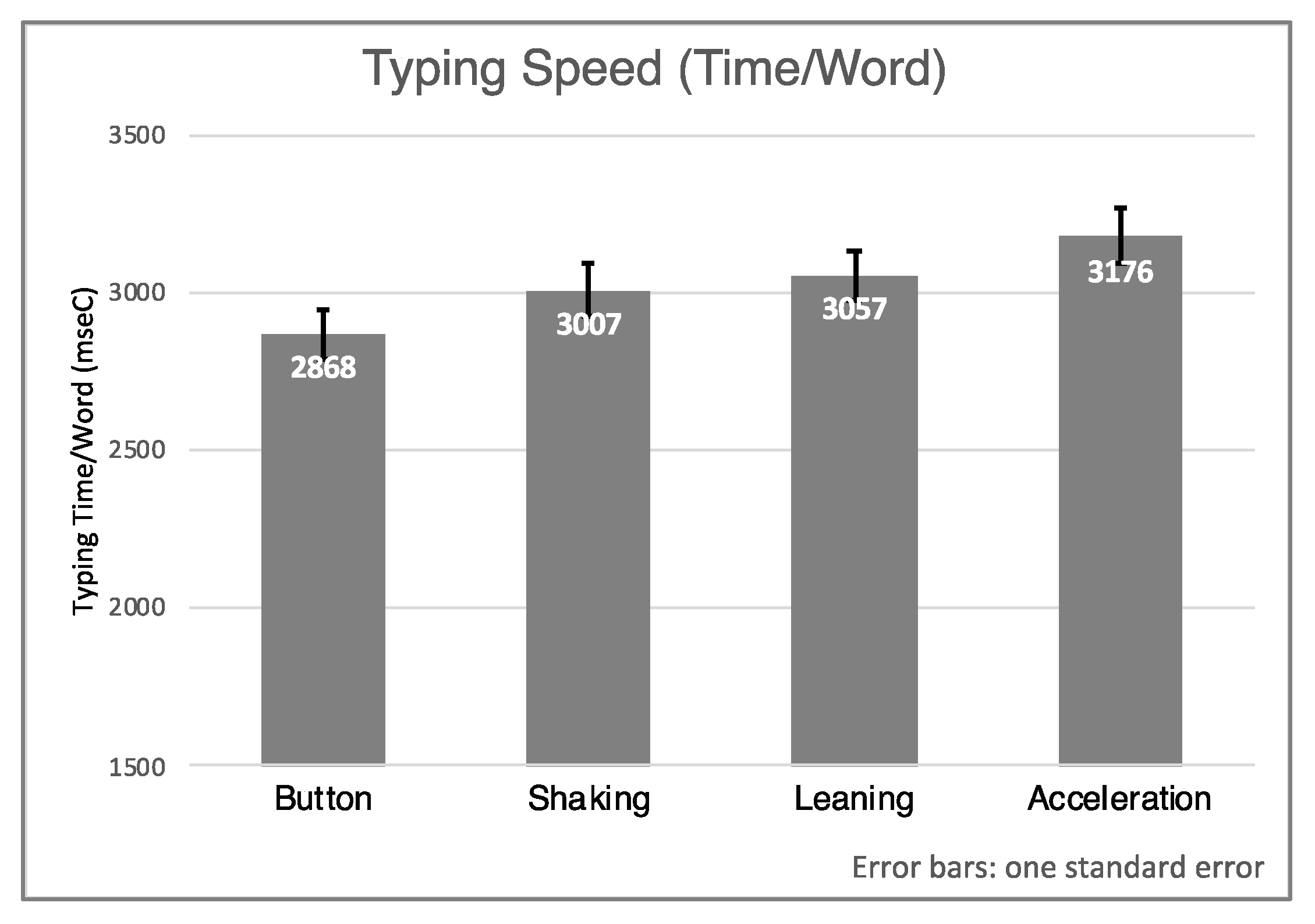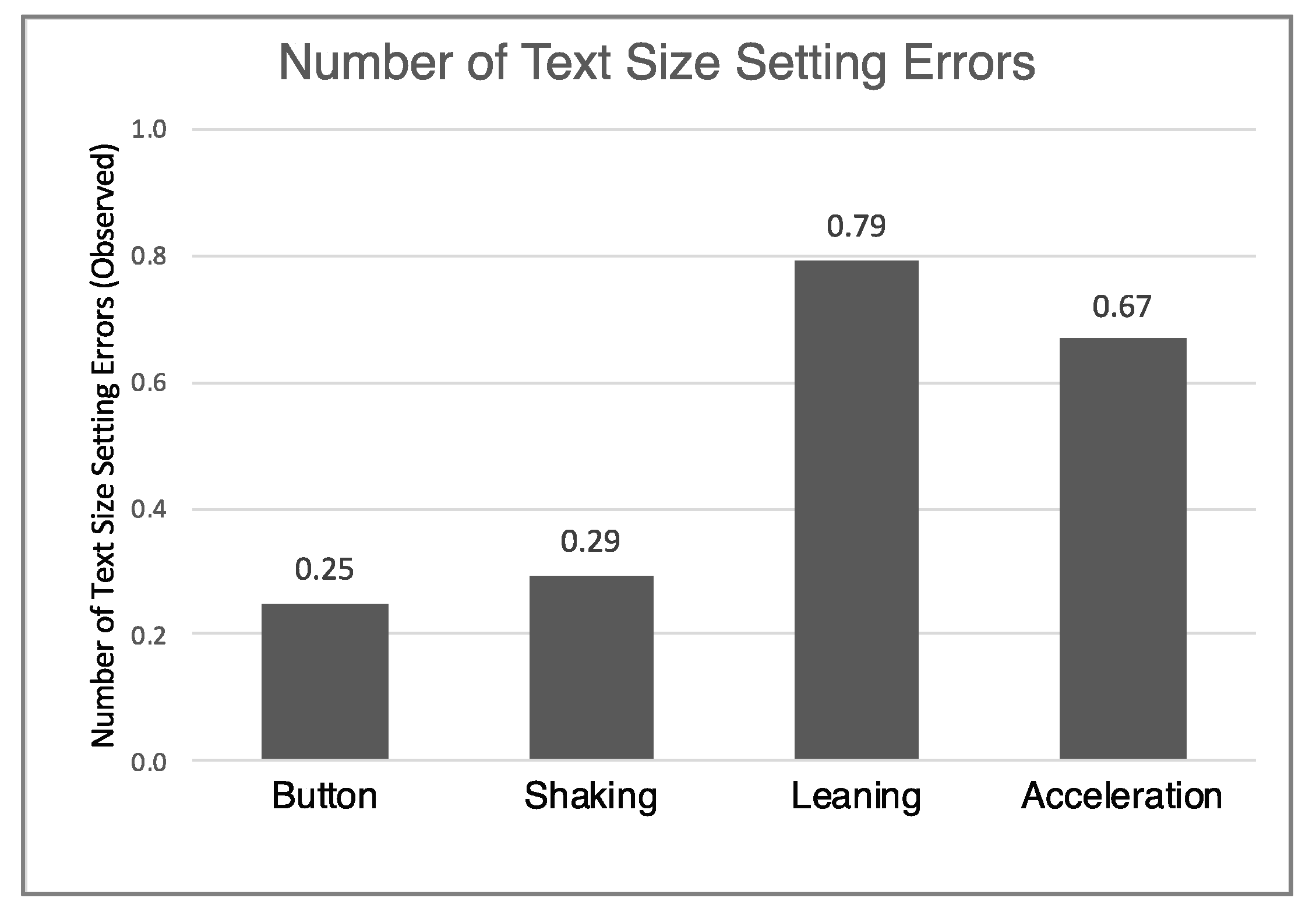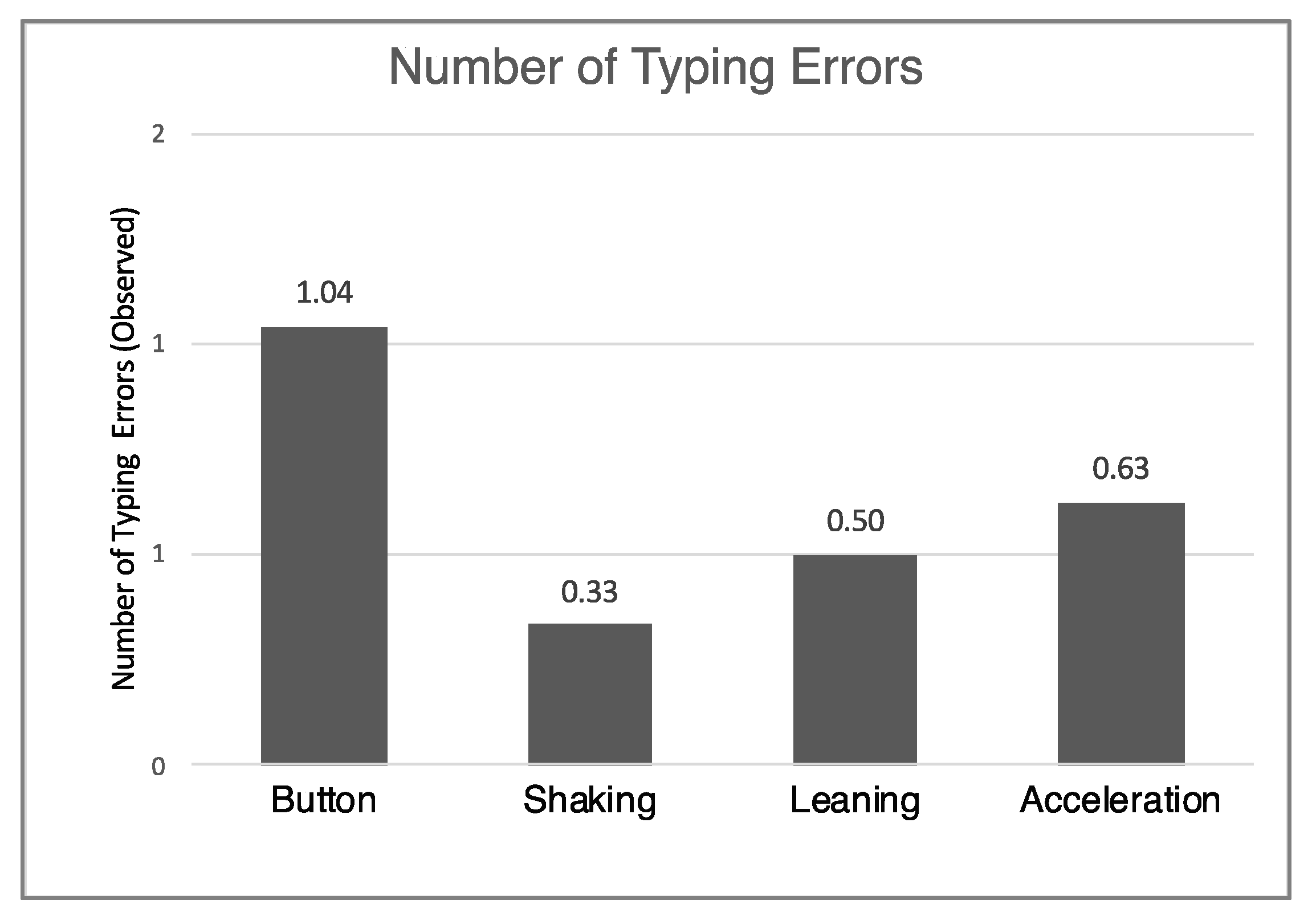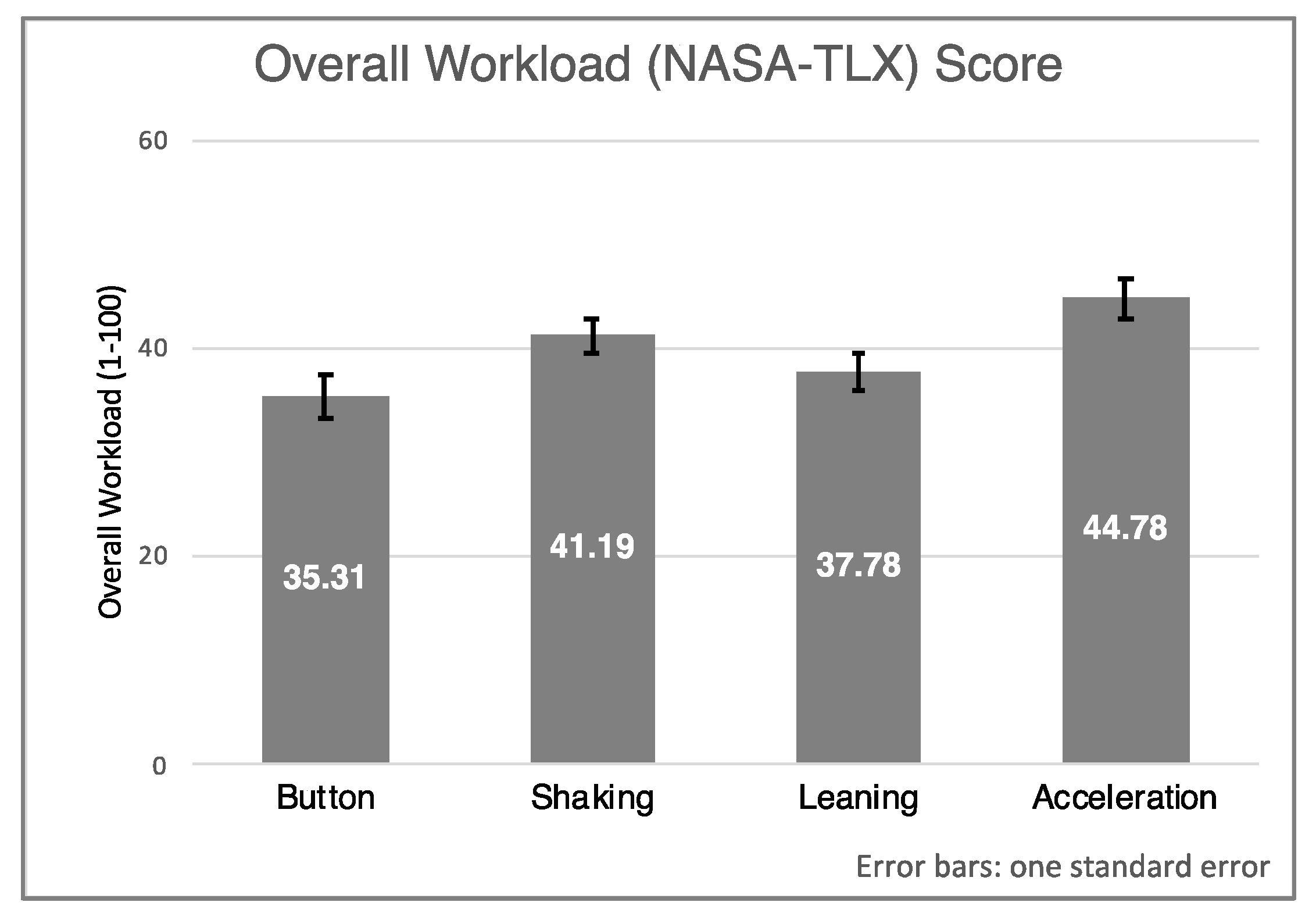1. Introduction
1.1. Gesture Interaction for Text Input on Mobile Devices
Mobile devices require different interactions compared to traditional fixed computer environments, such as touch-based selection and text input, due to their portability and mobility. In particular, with the use of various sensors such as accelerometers and gyroscopes in mobile devices, motion gestures beyond conventional taps and touches are possible. That is, users can perform simple tasks on mobile devices using gestures such as wrist flicking, tilting, or shaking the phone.
When communicating with others using mobile devices, text input remains one of the primary forms of user interaction, whether it is composing and sending text messages or leaving posts on various communities, in addition to voice calls. However, the virtual keyboard on smartphones is relatively small compared to the physical keyboard on desktops, resulting in slower text input speeds and the inability to implement hardware keyboard shortcuts. This leads to inefficient text manipulation tasks, including changing text features such as font, size, or color. For these reasons, previous studies [
1,
2,
3] have explored new gesture-based functions for mobile phones and sought more effective gesture features to improve typing speed and text editing usability on these devices.
Related existing studies have focused on utilizing gestures to enhance the user experience of smartphones beyond touch interactions. Le et al. [
4] demonstrated that while the latest smartphones are equipped with 22 gesture interactions, physical keyboards provide more than 800 hardware shortcuts. Wigdor and Balakrishnan [
5] presented a prototype called “TiltText” that aimed to improve the efficiency of text input for the T9 phone input method by tilting the phone. They integrated motion sensors on the back of the phone to capture user movements. The sensors determined the tilt angle of the phone and entered the required characters accordingly. According to the test results, the error rate was slightly higher compared to the original input method, but the input speed was 23% faster than the existing input method due to the new interaction approach.
Another research prototype called “TiltWriter” implemented text input on mobile devices using tilt gestures without touch actions on the device or screen [
6]. The authors suggested that the usability of this prototype could be considerably high and that the error rate could be as low as the standard Qwerty input method when users cannot perform touch actions on the screen.
The studies highlight the possibility of designing input methods that manipulate text attributes by leveraging appropriate gestures on mobile devices such as smartphones. Through this approach, users can perform more tasks, provide additional functionality, and extend the possibilities of existing input methods without disrupting the general text input process.
1.2. Manipulating Text Properties in Mobile Devices
In addition to input interface issues, there are other limitations to text-based conversations in Computer Mediated Communication (CMC), including mobile devices. This includes a lack of the ability to convey nonverbal cues such as facial expressions, body movements, and emotional nuances, which are essential aspects of communication. To address these limitations, methods have been introduced to integrate visual elements such as emoticons alongside text [
7]. Another approach is to manipulate text attributes to convey emotions during conversations.
Mackiewicz and Moeller [
8] demonstrated that all typefaces have different “personalities” or abilities to convey different emotions and moods. Participants evaluated typefaces based on various personality traits, revealing why certain characteristics were perceived more strongly. Among the various text attributes, Bayer et al. [
9] found that larger font sizes lead to more pronounced initial emotional impacts, suggesting that using larger fonts can effectively enhance the emotional expression of text.
However, conveying emotions through text messages with various text attributes requires a sequential process. Tang et al. [
10] identified two types of encoding in media: first encoding and second encoding. First encoding involves conveying basic information such as text, while second encoding adds additional elements such as size, color, bold, or italics to convey the intended meaning. In most text editing applications, users must complete secondary encoding tasks after the initial information encoding to modify text attributes and add intentions. This sequential process can be time-consuming and may require additional effort. To address this issue, Kim and Kaber [
11] proposed a new text editing method called “dynamic text editing” in a desktop computing environment. They developed a prototype text editor integrated with foot pedals, allowing users to change text attributes such as font size, face, and color while typing using a keyboard (first encoding). The experimental results demonstrated that using two-foot pedals with first-order control outperformed other foot control methods in terms of task performance, including speed, accuracy, and workload. The study also indicated that foot pedal methods could be as effective as conventional mouse-based methods for specific populations and situations.
Similarly, introducing additional font options for mobile text editing, such as chat messages, in a mobile environment can enable users to convey emotions or intentions [
12]. However, completing the secondary encoding process on mobile devices can be time-consuming and effortful. It often involves selecting the text to manipulate, accessing menus, searching for specific text features within options, selecting the desired option, and verifying changes while frequently shifting attention between the screen and fingers. This might be inefficient and require additional effort because the primary usage environment of mobile devices includes situations where users must perform tasks with one hand while on the move. Therefore, a more efficient approach is needed to perform both encoding tasks in a mobile environment.
1.3. Research Objectives
Various types of gestures for smartphone functions have been studied, but there is a lack of research investigating efficient input methods that utilize tilt gestures to modify text attributes such as text size. Tilt gestures have the potential to convey additional emotional information, but currently require complex manipulations in mobile interactions. Tilting and shaking the phone is often insufficient when performing complex editing tasks. However, according to a previous study by Le et al. [
4], integrating shortcut functions through tilt gesture control on smartphones can be advantageous. This highlights the need to simplify the process of changing font size by integrating tilt gestures while ensuring that these gestures do not interfere with users’ typical smartphone input actions. Additionally, introducing numerous gesture commands can increase users’ cognitive load and potentially lead to more errors. Considering that people are accustomed to simple touch gestures, finding alternative actions that complement touch gestures for modifying text attributes is a challenging task.
In this regard, the purpose of this study is to explore the tilt gesture interaction methods specifically designed for manipulating text attributes on mobile devices and to validate the usefulness of tilt gestures. Furthermore, the newly proposed tilt gesture manipulation was compared with the existing touch editing methods to determine whether tilt gestures can replace traditional touch button manipulation in text attribute manipulation. In conclusion, this investigation explored the characteristics of tilt gestures on mobile devices, particularly in relation to specific types of interactions.
2. Methods
An experiment was conducted using prototypes on a smartphone, including tilting gestures and conventional button methods to compare human performance using these methods. Although tablet devices also enable gesture interactions based on motion sensing, this study specifically targeted smartphones to validate the practicality of one-handed gesture-driven interaction methods.
2.1. Prototypes and Input Methods
The prototypes were developed for the experiment using the MIT App Inventor (
https://appinventor.mit.edu, accessed on 1 April 2025) on an Android phone and were presented on a Samsung Galaxy Note 3 smartphone device.
Figure 1a illustrates the initial screen of the application, displaying buttons for selecting different interaction methods, including ‘Manual-Button’, ‘Gesture-Shake’, ‘Gesture-Leaning’, and ‘Gesture-Accel’. Once a user clicks on a button, a prototype interface for text messaging appears, as shown in
Figure 1b. The text messaging interface consists of several sections.
The upper area displays the history of entered texts, along with the text size indicated within brackets: XS (extra-small), S (small), M (medium), L (large), and XL (extra-large). Below the text history panel, the text editing panel is positioned, accompanied by an ‘Enter’ button. This panel shows the text that the user is currently composing, including both the text content typed using the keyboard and the text size determined by the interaction methods (button or gesture). Once the text is prepared, the user needs to press the ‘Enter’ button to send the text to the text history panel, similar to a regular chatting application, but with the selected text size.
Beneath the text edit panel, there are five buttons available for setting the text size: ‘X Small’ (extra small), ‘Small’, ‘Medium’, ‘Large’, and ‘X Large’ (extra-large). The design choice to have five directly clickable buttons for text size was intended to reduce the cognitive load and allow for quick comparisons between traditional and gesture-based methods. The default text font size upon opening each prototype is ‘Medium’ and the color of the button indicates the currently selected text size. The user can choose the text size by either manually pressing the buttons or utilizing tilt gestures, depending on the selected interaction method. At the bottom of the screen, a standard virtual QWERTY keyboard is provided for text input. The four different interaction methods were prototyped to set the text sizes.
‘Manual-Button’: This method follows the traditional approach. Users can press one of the five text size buttons located above the keyboard to select the desired text size. They can make the selection either during or after completing a text entry. The chosen text size applies to the entire text in the text entry panel. After selecting the text size, users can press the ‘Enter’ button to send the text.
‘Gesture-Shaking’: With this method, users can change the font size by shaking the phone. The prototype is designed to detect shaking through the smartphone’s accelerometer sensors. The sensitivity of the accelerometer sensor is set to a moderate level in the App Inventor, and the minimum interval between shakes is 400 milliseconds. Each shake increases the font size by one level, starting from ‘X Small’ and progressing to ‘Small’, ‘Medium’, ‘Large’, and finally ‘X Large’. When the phone is shaken while the font size is already ‘X Large,’ it cycles back to ‘X Small’.
‘Gesture-Leaning’: In this prototype method, users tilt the phone either forward or backward to adjust the font size level. To maintain the current font size, users must hold the phone at a consistent tilt angle. The level of tilt is determined based on the relative angular degree of the phone’s pitch, using the reference angle from the smartphone’s orientation sensor. The reference angle is set or reset when the application is opened or after the previous text is entered by clicking the ‘Enter’ button. The font sizes are associated with specific tilt angle ranges: ‘Normal’ for −10 to 10 degrees, ‘Large’ for −10 to −25 degrees, ‘X Large’ for less than −25 degrees, ‘Small’ for 10 to 25 degrees, and ‘X Small’ for greater than 25 degrees. Users must maintain the tilt angle to retain the desired text font size since the tilt angle determines the font size level as a 0-order control.
‘Gesture-Acceleration’: Similar to the ‘Leaning’ method, this approach also involves tilting the smartphone. However, in this case, tilting the phone forward beyond 20 degrees from the reference angle continues to increase the font size level until reaching ‘X Large.’ Tilted back more than 20 degrees, the font size level progressively decreases until reaching ‘X Small’. Beyond ‘X Small’, tilting back again will increase the level back to ‘X Large,’ creating cyclic behavior.
2.2. Tasks
Each participant was instructed to create 10 sentences in each trial using specific text sizes, simulating the process of typing messages in texting or chatting applications on a smartphone. The decision to use entire sentences with a uniform text size was made to ensure consistency across trials and reduce variability due to other factors. This approach allowed us to isolate and assess the fundamental interactions when using different methods, providing clear initial data on the effectiveness of each gesture type. However, it is acknowledged that in real-world scenarios, the size of specific words or phrases is often changed rather than entire sentences. This is indeed an important aspect to consider when evaluating the practical applications of gesture-based interactions.
To familiarize participants with the methods, four practice trials were conducted, one for each interaction method, utilizing a set of designated practice sentences. The practice sentences included specified levels of text size indicated next to each sentence. A sample sentence set is illustrated in
Figure 2.
The sentences used in both the practice and test trials consisted of 47 words for the practice trial and 67 words for the test trial. The five levels of text size were evenly distributed across the 10 sentences, resulting in each font size appearing twice in the task document. However, consecutive sentences featured different text sizes, as depicted in
Figure 2. Throughout the experiment, participants were instructed to input the sentences from the task document one by one into the prototype application and send messages while adhering to the font size requirements specified at the beginning of each sentence.
To minimize potential order and learning effects in the analysis, the presentation order of the input prototype methods was randomized for each participant.
2.3. Participants
A total of 24 participants were recruited for the current study to take part in the experiment. The recruitment criteria specified that participants should have prior experience using smartphones, particularly in the context of text editing and messaging functions. Additionally, proficiency in the English language for both conversation and text input was required. The age range of the participants varied from 18 to 35 years, with a mean age of 25.33 years. Out of the recruited participants, eleven were male and thirteen were female. The recruitment process involved distributing email flyers to potential participants, and their participation in this study was voluntary. Notably, the majority of participants were undergraduate and graduate students. This choice was intentional, ensuring that participants had a high level of familiarity with mobile technology, facilitating efficient engagement with new interaction methods. While this might limit the observable advantages of tilt gestures to those who are less adept at technology, it ensures that the results reflect the interaction methods themselves, minimizing confounding factors related to a learning curve.
As part of the experimental procedure, the participants were asked to complete a survey before the practice trial to gather general information about the sample population. Using a scale ranging from 1 (indicating no experience) to 5 (indicating frequent experience), participants provided an average rating of 4.38 for their overall experience with smartphones (sd = 0.92), a rating of 4.08 for their experience with virtual QWERTY keyboards on smartphones (sd = 0.88), and a rating of 4.29 for their experience with chatting applications on smartphones (sd = 0.75). These ratings indicate that the participants had considerable familiarity with smartphones and chat applications.
All aspects of the experimental procedures, including participant recruitment, data collection, and data analysis, were conducted with the approval of the Institutional Review Board (IRB) at the University of Michigan. The research procedure received an IRB exemption after undergoing review.
2.4. Variables and Measurement
In the experiment, the independent variable (IV) was the selection method for text size in the prototype application, which included four interaction methods: ‘Manual-Button’, ‘Gesture-Shake’, ‘Gesture-Leaning’, and ‘Gesture-Acceleration’. The dependent variables (DVs), as measures, included time-to-task completion (TTC), the number of errors, and subjective workload. TTC referred to the time taken by participants to generate all ten sentences from the task document using each method. The number of errors was gauged in two dimensions: the number of instances where the font size selection was incorrect and occurrences of spelling or typing errors in the message. Standard statistical methods were rigorously applied to evaluate these performance differences, ensuring the reliability of the findings. Participants were instructed to complete input tasks swiftly and accurately using the selection methods. Subjective workload during test trials was measured using the NASA-TLX. Subjects completed the rating form after each test trial, and the demand ranking form was filled out upon the completion of all test trials. Following the conclusion of all test trials, the participants underwent approximately 10 min of interviews to gather subjective satisfaction and suggestions regarding the interaction methods.
2.5. Experimental Design and Procedure
The experiment followed a within-subject design, where each participant underwent one test trial with each selection method. A total of 96 trials (24 participants × 4 trials) were conducted, each yielding an associated dataset. The experiment commenced with an introduction to the research and prototype, allowing participants to pose questions. Informed consent was obtained and signed by all subjects. Subsequently, participants engaged in prototype practice, typing the 10 sentences from the practice task document. Each practice trial with a prototype interaction method lasted around 5 min, followed by a data-recording test trial. Post-test trial completion, the participants were required to fill out the workload evaluation sheet and NASA-TLX rating form. This sequence of practice trial, test trial, and workload evaluation was repeated four times for the four distinct prototype interaction methods. The presentation sequence of the interaction methods and task documents was randomized across participants and trials to mitigate ordering effects. Upon completing all four sets of trials, the participants filled out the NASA-TLX demand ranking form and underwent a brief interview.
3. Results and Discussion
3.1. Time-to-Task Completion (TTC)
The Time-to-Task Completion (TTC) data were transformed into typing speed, measured in milliseconds per word for each participant. The Analysis of Variance (ANOVA) results indicated a significant difference in the average typing speed per word among the four selection methods for text size (
F(3, 54) = 5.12,
p = 0.003). A post-hoc analysis using Tukey (
alpha = 0.05) identified two groups: one comprising ‘Button (
M = 2868 ms)’, ‘Shaking (
M = 3007 ms)’, and ‘Leaning (
M = 3057 ms)’ and another consisting of ‘Shaking’, ‘Leaning’, and ‘Acceleration (
M = 3176 ms)’. That is, the effects of the ‘Button’, ‘Shaking’, and ‘Leaning’ methods have no statistically significant differences among each other, and they are grouped together as one cluster. Similarly, ’Shaking’, ‘Leaning’, and ‘Acceleration’ form another group with no significant differences among them. This result indicates that ’Shaking’ and ‘Leaning’ are included in both groups, meaning there is no significant difference between ‘Shaking’ and ‘Leaning’, and neither has a significant difference from ‘Button’ or ‘Acceleration’. However, since ‘Button’ and ‘Acceleration’ belong to separate groups, it implies that there is a statistically significant difference between ‘Button’ and ‘Acceleration’.
Figure 3 displays the mean TTC for the four text-size changing methods and
Table 1 shows the pos-hoc analysis results, including the Tukey pairwise comparison test for the typing speeds.
The findings suggest that although the traditional button method results in a faster task completion time, including font size changes, compared to gesture methods based on the sample mean, the two gesture methods (‘Shaking’ and ‘Leaning’) exhibit similar task completion speeds to the button method. However, it was also observed that the ‘Acceleration’ method significantly prolonged the task completion time.
3.2. Number of Text Editing Errors
Text editing errors, encompassing text size setting errors and typing errors, were recorded during the test trials. Specifically, if a participant configured a different text size level than the one stipulated in the task document, it was recorded as a text size setting error. Typing errors, excluding size settings, such as spelling mistakes, were categorized as typing errors. Due to the limited number of errors in each trial and the characteristics of the dataset, a non-parametric test (Kruskal–Wallis) was employed.
The results demonstrated the significant impact of the selection methods on the number of text size setting errors (
χ32 = 12.43,
p = 0.006). As depicted in
Figure 4, the ‘Buttons (M = 0.25)’ and ‘Shaking (
M = 0.29)’ methods exhibited markedly fewer text size setting errors compared to the ‘Leaning (
M = 0.79)’ and ‘Acceleration (
M = 0.67)’ methods. Participant observations and feedback provided insights into the primary reasons behind this outcome. The participants noted a need for extreme caution when adjusting the text size level using the leaning and acceleration methods, as slight pitch movements could lead to changes in text size levels. The participants found it easier to set the level through discrete actions like button pressing or snap shaking, where normal and slight movements did not affect level selection. In essence, selecting discrete control (text size levels) through continuous hand movement (pitch changes in the mobile device) posed challenges for operators because the thresholds of each step were not clear or visible, as in gesture control movements.
The Kruskal–Wallis tests also revealed the marginally significant effects of the prototype methods on the number of typing errors (
χ32 = 6.86,
p = 0.076). Intriguingly, as illustrated in
Figure 5, the ‘Button’ method resulted in more typing errors (
M = 1.04), while the ‘Shaking’ method led to fewer errors (
M = 0.33). This outcome may be attributed to the proximity of the text size setting buttons to the virtual keyboard, leading participants to accidentally press letter keys while adjusting text size settings.
3.3. Subjective Workload
A series of ANOVAs were conducted on both the overall workload score, calculated through a rank-weighted sum ranging from 1 to 100, and ratings for each of the six dimensions of NASA-TLX, with scores ranging from 1 to 10. The findings indicated a significant difference in the average overall workload ratings for the four text size setting methods (
F(3, 54) = 6.75,
p = 0.001).
Figure 6 illustrates the mean subjective workload for each method. Tukey’s multiple comparison tests identified two potential groups: one comprising the ‘Button (
M = 35.31)’, ‘Leaning (
M = 37.78)’, and ‘Shaking (
M = 41.19)’ methods, and another consisting of the ‘Shaking’ and ‘Acceleration (
M = 44.78)’ methods. The results suggest no significant difference in user workload between the two gesture methods (‘Leaning’ and ‘Shaking’) and the button method, while the acceleration method markedly increases the workload, as shown in
Table 2, which displays the Tukey pairwise comparisons between the prototype methods. That is, both the ‘Leaning’ and ‘Shaking’ gestures have an impact on workload similar to the ‘Button’ method, but the ‘Acceleration’ method tends to significantly raise the workload compared to the ‘Button’ and ‘Leaning’ methods.
A series of ANOVAs on the ratings for each dimension in NASA-TLX offers a more detailed insight into the differences in workload. Among the six dimensions of NASA-TLX (mental demand, physical demand, temporal demand, performance, effort, and frustration), ratings on physical demand (F(3, 54) = 7.57, p < 0.001), performance (F(3, 54) = 2.90, p = 0.043), and effort (F(3, 54) = 10.79, p < 0.001) varied significantly among the five prototype methods. A post-hoc analysis of these three dimensions revealed a consistent pattern with the overall NASA-TLX score. That is, the ‘Leaning’ and ‘Shaking’ gestures result in a workload that is similar to the ‘Button’ method, whereas the ‘Acceleration’ method significantly increases the workload compared to the ‘Button’ and ‘Leaning’ methods.
3.4. Post-Experiment Questionnaire and Interview
Upon completing all test trials, the participants were tasked with rating the four prototype methods employed in the experiment on a scale from 1 to 7, gauging their perceived usefulness (1 denoting “not useful”, and 7 denoting “very useful”). The button method for setting text size received the highest rating, averaging 5.67. The mean ratings for the ‘Shaking’ and ‘Leaning’ methods exceeded 5, indicating a perception of fair usefulness.
Regarding the query, “Do you believe that adding the ability to change the font size in your smartphone’s chat messages will help you better express your feelings?” more than 90% of the participants concurred (22 out of 24), suggesting that the feature allowing users to adjust text size on mobile devices may be well received.
In addition to the questionnaire, a semi-structured interview was conducted to gather general comments and suggestions on the text size setting feature and the interaction methods, including gestures. The following are the participants’ collective general comments.
‘Button’ method: While the touch method remains a practical and familiar interaction method, participants noted that the prototype interface’s added buttons for text size selection occupied a significant portion of the mobile screen. Suggesting the addition of another button to launch a dialog box for text size settings, they acknowledged potential concerns about increasing the number of user clicks.
‘Shaking’ method: Similar to the ‘Button’ method, the shake method appeared designed for accurate choice actions and outperformed the other two new interaction prototypes when selecting font sizes using gestures. However, participants pointed out that the shake operation demanded higher physical effort.
‘Leaning’ method: Overall, this method garnered more positive feedback. Participants considered the ‘Leaning’ method an original and effective prototype, albeit while expressing concerns about the mobile phone’s tilting angle not always being maintained, leading to inadvertent changes in text font size.
‘Acceleration’ method: The participants, based on experimental trials and interviews, expressed discomfort and mentioned making many mistakes with the ‘Acceleration’ method. They indicated that this prototype method required substantial practice to become familiar with, even with extensive training, making quick and accurate font size selection challenging.
4. Overall Discussion
In general, the ‘Button’ method prototype outperformed the other gesture interaction methods, except for the increase in typing errors attributed to button location. This discrepancy arises from the participants’ unfamiliarity with gesture methods, requiring a substantial amount of time for users to become accustomed to them. Despite this, the experiment’s results unveil intriguing findings. Specifically, the ‘Leaning’ and ‘Acceleration’ methods exhibited longer completion times, and a higher number of errors compared to the ‘Button’ and ‘Shaking’ methods. Task performance was similar between the ‘Button’ and ‘Shaking’ methods, with both proving better at setting the designated text size level, as evident in the subjective questionnaires and interviews. These methods simply required users to click a corresponding button or shake the device a specified number of times.
For ‘Leaning’ and ‘Acceleration,’ the participants encountered difficulties setting specific text size levels, as they needed to maintain or adjust the mobile device’s angle while continuously monitoring text size changes. Beyond the learning curve and familiarization level, the results suggest the significance of input and output control compatibility in gesture interaction. Since the required system inputs are discrete (selecting an option among five text size levels), discrete human behaviors for inputs, like pressing a button or shaking the device for a specific duration, proved more effective in terms of task performance. Conversely, employing continuous behavior, such as leaning an input device to select a discrete option without clear feedback of a threshold, posed challenges for users, resulting in poorer task performance.
Despite the lower task performance of the leaning and acceleration methods compared to the ‘Button’ and ‘Shaking’ methods, they may find utility in specific task environments. Firstly, the ‘Leaning’ and ‘Acceleration’ methods enable users to manipulate text size while concurrently typing, as the text size changes with the pitch angle of the mobile device without interrupting specific behaviors. The ‘Button’ and ‘Shaking’ methods necessitate users to pause a text entry to adjust the text size by pressing a button or shaking the device, potentially degrading text entry performance over time. Secondly, if the interface offers a large number of text size options that are perceived as continuous, the ‘Leaning’ and ‘Acceleration’ methods could be more beneficial than ‘Button’ and ‘Shaking’. In such cases, feedback on the current text size level, based on device pitch, should be explicitly visible in a continuous manner, accompanied by a widget allowing continuous input, like a slider, rather than buttons.
While this study did not find that tilt gestures significantly surpass traditional touch methods, the exploration remains crucial for uncovering new interaction possibilities. While the analyses did not show a significant superiority of tilting gestures over traditional methods, the comparable performance of ‘Shaking’ and ‘Leaning’ gestures indicates that these methods could serve as viable alternatives without clear disadvantages. Despite challenges like the steep learning curve and physical effort, especially in ‘Leaning’ and ‘Acceleration,’ tilt gestures could offer significant value in scenarios where traditional touch input is impractical. Their potential in enhancing accessibility and enabling hands-free operation warrants further investigation.
5. Conclusions
This research compared the usability of tilt gesture interaction methods, including ‘Shaking’, ‘Leaning’, and ‘Acceleration’, with the conventional button method for selecting text sizes in a mobile text entry interface. The primary goal was to evaluate these methods based on task completion time, error rate, workload, and subjective satisfaction. The results demonstrated that the ‘Shaking’ gesture method matched the traditional button method in performance, highlighting its potential as an intuitive alternative for text size manipulation.
While this study did not find a significant superiority of tilt gestures over traditional touch methods, the comparable performance of the ‘Shaking’ and ‘Leaning’ gestures suggests that these methods could be viable alternatives without clear disadvantages. These findings underscore the importance of exploring gesture-based interactions, particularly in scenarios where traditional touch input may be impractical, such as when hands-free interaction is preferred or for enhancing accessibility.
Participant feedback revealed a learning curve associated with gesture methods, indicating that increased familiarity could enhance their effectiveness on mobile devices. Beyond text manipulation, tilt gestures hold potential for application in scenarios requiring incremental or decremental control, potentially expanding the scope of user interactions on mobile devices.
The potential contributions of this research are multifaceted, providing insights into the development of more intuitive and context-sensitive mobile interfaces. By integrating gesture-based interactions into broader contexts—such as app navigation, gaming, or multimedia controls—this study lays the groundwork for advancements in interaction design.
Moreover, by enabling users to express emotions through text size modification, such gestures add a deeper layer of personalization and expressiveness to digital communication. Although this study is preliminary and conducted within the controlled constraints of a laboratory environment with a specific demographic of participants, it highlights valuable areas for further inquiry.
This study has several limitations. The participant group was small and primarily composed of students, which may limit the generalizability of the findings. The controlled laboratory environment and predefined message tasks do not fully capture the flexibility and emotional expression present in real-world scenarios. These constraints highlight the need for future research to include a more diverse participant pool and to explore gesture interactions in more dynamic and realistic settings.
Future research should focus on addressing these limitations and expanding the application of gesture-based interactions in various domains. By exploring these pathways, we aim to significantly contribute to the development of more intuitive and effective gesture-based interaction methods for mobile devices, ultimately transforming how users interact with technology.
Author Contributions
Conceptualization, S.-H.K. and X.L.; methodology, S.-H.K. and X.L.; software, S.-H.K.; validation, S.-H.K. and X.L.; formal analysis, S.-H.K.; investigation, X.L.; resources, S.-H.K.; data curation, X.L.; writing—original draft preparation, X.L.; writing—review and editing, S.-H.K.; visualization, X.L.; supervision, S.-H.K.; project administration, S.-H.K.; funding acquisition, S.-H.K. All authors have read and agreed to the published version of the manuscript.
Funding
This research received no external funding.
Institutional Review Board Statement
This study was conducted with the approval of the Institutional Review Board (IRB) at the University of Michigan. The research procedure received an IRB exemption after undergoing review on 11 March 2021 (HUM00196117).
Informed Consent Statement
Informed consent was obtained from all subjects involved in this study.
Data Availability Statement
Data could be provided upon request from the corresponding authors.
Conflicts of Interest
The authors declare no conflicts of interest.
References
- Jain, A.; Kanhangad, V. Exploring orientation and accelerometer sensor data for personal authentication in smartphones using touchscreen gestures. Pattern. Recognit. Lett. 2015, 68, 351–360. [Google Scholar] [CrossRef]
- Jahani, H.; Kavakli, M. Exploring a user-defined gesture vocabulary for descriptive mid-air interactions. Cogn. Technol. Work. 2018, 20, 11–22. [Google Scholar] [CrossRef]
- Yi, S.; Qin, Z.; Novak, E.; Yin, Y.; Li, Q. Glassgesture: Exploring head gesture interface of smart glasses. In IEEE INFOCOM 2016, Proceedings of the 35th Annual IEEE International Conference on Computer Communications, San Francisco, CA, USA, 10–14 April 2016; IEEE: Piscataway, NJ, USA, 2016; pp. 1–9. [Google Scholar]
- Le, H.V.; Mayer, S.; Weiß, M.; Vogelsang, J.; Weingärtner, H.; Henze, N. Shortcut gestures for mobile text editing on fully touch sensitive smartphones. ACM Trans. Comput.-Hum. Interact. 2020, 27, 1–38. [Google Scholar] [CrossRef]
- Wigdor, D.; Balakrishnan, R. A comparison of consecutive and concurrent input text entry techniques for mobile phones. In Proceedings of the SIGCHI Conference on Human Factors in Computing Systems, Vienna, Austria, 24–29 April 2004; pp. 81–88. [Google Scholar]
- Castellucci, S.J.; MacKenzie, I.S.; Misra, M.; Pandey, L.; Arif, A.S. TiltWriter: Design and evaluation of a no-touch tilt-based text entry method for handheld devices. In Proceedings of the 18th International Conference on Mobile and Ubiquitous Multimedia, Pisa, Italy, 26–29 November 2019; pp. 1–8. [Google Scholar]
- Stark, L.; Crawford, K. The conservatism of emoji: Work, affect, and communication. Soc. Media Soc. 2015, 1, 2056305115604853. [Google Scholar] [CrossRef]
- Mackiewicz, J.; Moeller, R. Why People Perceive Typefaces to have Different Personalities. In Proceedings of the Professional Communication Conference, IPCC, Minneapolis, MN, USA, 29 September–2 October 2004; pp. 304–313. [Google Scholar]
- Bayer, M.; Sommer, W.; Schacht, A. Font size matters—Emotion and attention in cortical responses to written words. PLoS ONE 2012, 7, e36042. [Google Scholar] [CrossRef] [PubMed]
- Tang, L.; Fourney, D.; Huang, F.; Carter, J. Secondary Encoding. In Proceedings of the Human Factors and Ergonomics Society Annual Meeting, New York, NY, USA, 22–26 September 2008; Volume 52, pp. 561–565. [Google Scholar]
- Kim, S.-H.; Kaber, D.B. Design and evaluation of dynamic text-editing methods using foot pedals. Int. J. Ind. Ergon. 2009, 39, 358–365. [Google Scholar] [CrossRef]
- Choi, S.; Aizawa, K. Emotype: Expressing emotions by changing typeface in mobile messenger texting. Multimed. Tools Appl. 2019, 78, 14155–14172. [Google Scholar] [CrossRef]
| Disclaimer/Publisher’s Note: The statements, opinions and data contained in all publications are solely those of the individual author(s) and contributor(s) and not of MDPI and/or the editor(s). MDPI and/or the editor(s) disclaim responsibility for any injury to people or property resulting from any ideas, methods, instructions or products referred to in the content. |
© 2025 by the authors. Licensee MDPI, Basel, Switzerland. This article is an open access article distributed under the terms and conditions of the Creative Commons Attribution (CC BY) license (https://creativecommons.org/licenses/by/4.0/).
